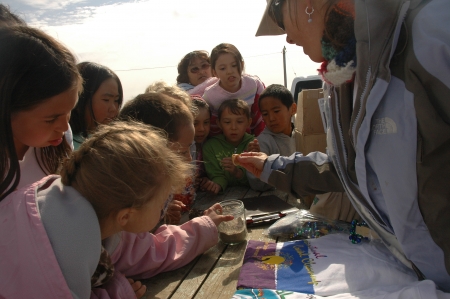About The Arctic In the Classroom Program

Program Archive (2016–2019)
The Arctic in the Classroom (TAC) was a community-centered education initiative led by the Arctic Research Consortium of the U.S. (ARCUS) from 2016 to 2019. The program aimed to strengthen Arctic-focused learning by building collaborative partnerships among scientists, educators, and community members to co-develop meaningful, place-based educational resources for K–12 students in Alaska.
Program Overview
The Alaskan Arctic is a science-rich region with compelling landscapes, ecosystems, and communities. Yet, Arctic science often remains inaccessible to the public, and students and educators frequently lack relevant, localized curriculum aligned with contemporary Science, Technology, Engineering, and Math (STEM) standards.
TAC addressed these challenges by:
- Bringing Arctic researchers into partnership with local educators and community leaders
- Supporting collaborative development of culturally relevant, Arctic-based STEM education resources
- Encouraging citizen science and community-based monitoring as tools for experiential learning
- Providing sustained training and support for both teachers and researchers
Each TAC team was composed of at least one scientist, one teacher, and one community member. Teams were empowered to design projects that reflected their expertise and addressed the needs and interests of their communities.
Goals & Objectives
- Actively engage Arctic K–12 students, teachers, and community members in real-world science
- Increase understanding of Arctic environments, change, and research
- Support scientist engagement in culturally responsive education and outreach
- Improve use of community-collected and quality-assured datasets in education
- Produce and share Arctic-focused K–12 educational resources
- Foster long-term collaborations and community capacity in science education
Program Launch: 2016 Make an Impact Workshop
The TAC program began with the Make an Impact workshop, held March 13–15, 2016, at the University of Alaska Fairbanks. This event brought together interdisciplinary teams to explore the potential of citizen science and community-based monitoring in Arctic classrooms. The workshop served as a launchpad for team formation and project development.
Visit the workshop event page here.
Project Teams
Each TAC project reflects the diversity of Arctic communities and the potential for education rooted in place, culture, and science. Explore the project pages to learn more about team members, goals, and educational resources developed.
Landscape Change in the Tundra: Citizen-Science Driven Arctic Observations
The Ice in My Backyard: Place-based Science Curriculum and Sea Ice Field Trip
Legacy & Impact
Though TAC is no longer an active program, it created a strong foundation for place-based Arctic education and community-science partnerships. It helped demonstrate the value of involving youth and educators in scientific research and highlighted the importance of culturally responsive approaches in Arctic education and outreach.
Key contributions include:
- Development of locally grounded STEM resources for Arctic classrooms
- Strengthened partnerships between scientists and Arctic communities
- Increased awareness of Arctic change among students, teachers, and researchers
- Expanded models for citizen science and community-based monitoring in education
Publications & Products
- Witness the Arctic article on TAC (June 2016)
- Erica Watson’s essay on the Make an Impact Workshop, published by The Arctic Institute
- 2019 working group: Culturally Responsive Outreach to Indigenous Alaska K–12 Students by Marine Scientists (Anchorage, AK)
Program Support
The Arctic in the Classroom was supported by the Arctic Research Consortium of the U.S. (ARCUS), with funding from applicable community service payments from federal court settlements and the North Pacific Research Board.
